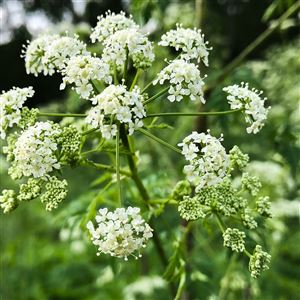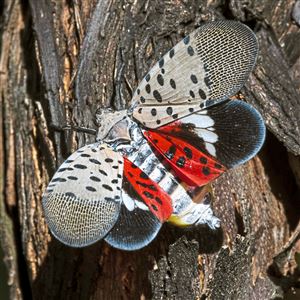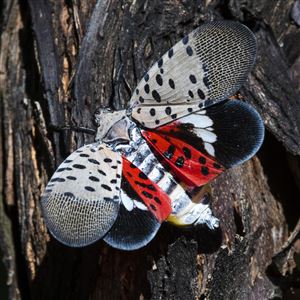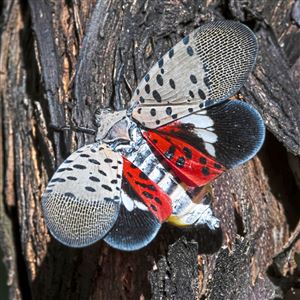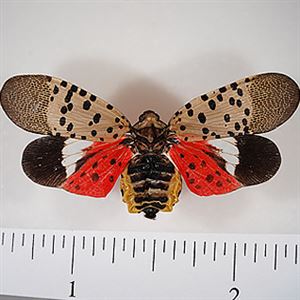The spotted lanternfly is migrating its way to Western Pennsylvania, but a dog is on its trail.
Lucky, a German shepherd based in Harrisburg, and her owner and handler, Shane Philipps, visit businesses to sniff out and exterminate egg masses of the invasive species.
Mr. Philipps, a Pennsylvania Department of Agriculture compliance and enforcement specialist, and Lucky visited Eichenlaub Inc., a landscaping business in Indiana Township, on Tuesday to demonstrate Lucky’s technique of finding the egg masses under trucks and cars and in stockpiles of stone.
Being the first dog in the nation trained to detect the egg masses, Lucky is able to sniff in hard to reach areas, and with 225 million scent receptors in her nose, compared to the 40 million in humans’ noses, she is equipped to do what we cannot.
As a puppy, she was trained at the Penn Vet Working Dog Center in Philadelphia and has detected four egg masses since she began licensed work under the state Department of Agriculture in November 2020.
Every time Lucky finds an egg mass, she’s rewarded with a play session.
“That’s kind of what the game is, really,” said Mr. Philipps. “They teach them a game. They take their prey drive that is natural to them to go hunt stuff and they transfer that drive to a toy. She just wants to play.”
Each spotted lanternfly egg mass contains up to 50 eggs, which are laid in the fall and hatched in the spring. Lucky works from the start of October until the end of May.
Joined by the two to talk about the effect of the spotted lanternfly and mitigation efforts were representatives from a partnership of agencies, including Pennsylvania Agriculture Secretary Russell Redding, Penn State College of Agricultural Sciences Dean Rick Roush and U.S. Department of Agriculture Deputy Administrator Carlos Martinez.
“It is one of those interesting issues where it is a convergence of the science and the civics,” said Mr. Redding. “Science will solve this problem, but there’s a whole civics part of this, where you have to be aware, engaged, thinking — change your habits and thinking about ‘how do I take my responsibility.’”
The spotted lanternfly first migrated to Pennsylvania, specifically in Berks County, in 2014 from Southeast Asia. Known as an invasive species, the insect feeds on over 70 plant species such as grape vines, hops, apple trees and hardwood trees, leaving behind a sticky honeydew that can turn into a sooty mold.
Over the seven years, the species has migrated via rail lines, turnpike and other major transportation corridors from Eastern to Western Pennsylvania, allowing for 34 counties to be put under the quarantine order, including Allegheny County. It has been seen in six other states, as well.
Businesses within these areas that travel to other areas within and out of the quarantine zone must fill out a form to acquire a permit to move equipment; disregarding the permit can result in a fine of up to $300.
Citizens are encouraged to mitigate the spread of the spotted lanternfly too in places Lucky cannot, such as forests, backyards, personal vehicles and other private land.
Forms can be filled out to mark locations where there have been spotted lanternfly sightings, which are marked in a database. A high quantity will bring a response by the Pennsylvania Department of Agriculture to control it. As of August 2020, there were 62,924 reported sightings of the insect for the year — up 72% since the same time the year before.
Leaving the spotted lanternfly unchecked can result in destroyed crops and lost agriculture jobs.
In the past three years, more information about the spotted lanternfly has been learned, making mitigation efforts more successful.
“We’ve worked out the life cycle and the timing of the pests,” said Mr. Roush. “We’ve worked out its seasonal changes and preferred host plants, so we can do a better job of mapping how it moves from place to place as adults.”
On top of Lucky’s efforts, the Pennsylvania Department of Agriculture has developed traps and is currently testing out sprays.
Ruth Welliver, director of the Bureau of Plant Industry at the state Department of Agriculture said individuals can kill the insects. “But there are some things that people are trying that are not safe. People are throwing bleach on their bushes, and that will kill the lanternfly, but it also affects other things. So you have to be careful with what you try.”
First Published: June 23, 2021, 9:49 a.m.
Updated: June 23, 2021, 2:06 p.m.









